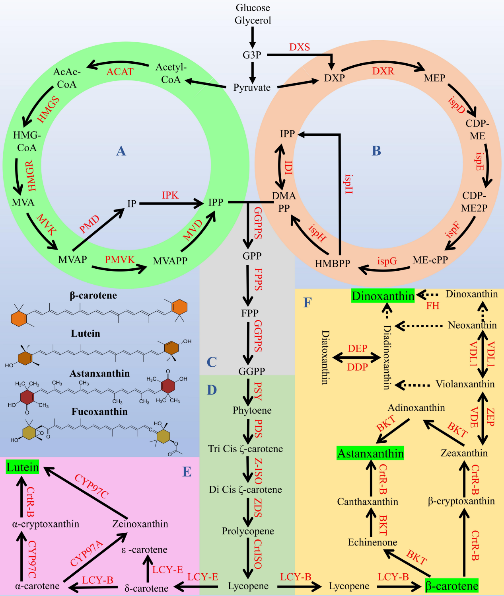Recently, Professor Gao Zhengquan and his team (Microbial Metabolic Engineering and Efficient Utilization Team) from School of Pharmacy (Wine School) published a paper entitled Metabolic engineering and synthetic biology strategies for producing high-value natural pigments in microalgae in Biotechnology advances (IF 16.0, ranked 3rd among 121 journals of applied microbiology and biotechnology, and ranked 5th among 299 journals of biochemistry and molecular biotechnology), a top biotechnology journal. Binzhou Medical University was the signature unit of the first author and the only corresponding author unit. Cao Kai, a graduate student enrolled in 2021 (under joint training), Associate Professor Cui Yulin, and Adjunct Professors Sun Fengjie of BMU were the co-authors. Professor Gao Zhengquan and Professor Meng Chunxiao were the corresponding authors. The link of the paper is: https://doi.org/10.1016/j.biotechadv.2023.108236.


The paper is mainly about the discussion of the classification of microalgae pigments, natural synthetic pathways, health, economic value, application fields; the application of metabolic engineering, synthetic biology, multi-omics and CRISPR (gene editing) technologies in constructing highly pigment-producing microalgal cell factories as well as the latest cutting-edge research; and the outlook on the challenge and prospect of the future development of microalgae pigments’ commercial production. The paper provides richer relevant information for practitioners in biomedicine, functional food, aesthetic medicine and cosmetics, and aquaculture related industries. It also provides a roadmap of microalgae engineering transformation strategies for relevant scientific researchers, as well as a new perspective for the efficient transformation of related achievements.


Recently, Professor Gao Zhengquan and his team has published three research papers in the field of green biofabrication. The paper entitled Promoting heme and phycocyanin biosynthesis in Synechocystis sp. PCC 6803 by overexpression of porphyrin pathway genes with genetic engineering is published in Marine Drugs ( JCR Q1, IF 5.4), and its link is: https://doi.org/10.3390/md21070403. The paper entitled Improved biosynthesis of heme in Bacillus subtilis through metabolic engineering assisted fed-batch fermentation is published in Microbial Cell Factories (JCR Q1, IF 6.4), and its link is: https:// doi.org/10.1186/ s12934-023-02077-3. The above two papers are about the use of genetic engineering and metabolic engineering to respectively modify cyanobacteria Synechocystis PCC 6803 and Bacillus subtilis to efficiently produce heme and phycocyanin with medicinal value. The research results show that these two microorganisms have good application prospects for heme and phycocyanin production. The paper entitled Screening and identification of genes involved in β-alanine biosynthesis in Bacillus subtilis is published in Archives of Biochemistry and Biophysics (JCR Q1, IF 3.9), and its link is: https:// doi. org/10.1016/j.abb.2023.109664. The paper is about the use of modular engineering and synthetic biology to modify the biologically safe Bacillus subtilis to produce beta-alanine, a food additive that has swept the body fitness world. The corresponding authors of the paper published in Marine Drugs are Meng Chunxiao and Gao Zhengquan, the corresponding author of the other two papers is Gao Zhengquan, and Binzhou Medical University is the corresponding author unit.
The above four research papers are supported by National Natural Science Foundation of China, Major Basic Research Program of the Natural Science Foundation of Shandong Province, Natural Science Foundation of Shandong Province, Innovation and Entrepreneurship Leading Team and Science and Technology Leading Talent Projects in Yantai Economic and Technological Development Area, and the Start-up Fund of Binzhou Medical University.
BY: Meng Chunxiao
SOURCE:The School of Pharmacy





